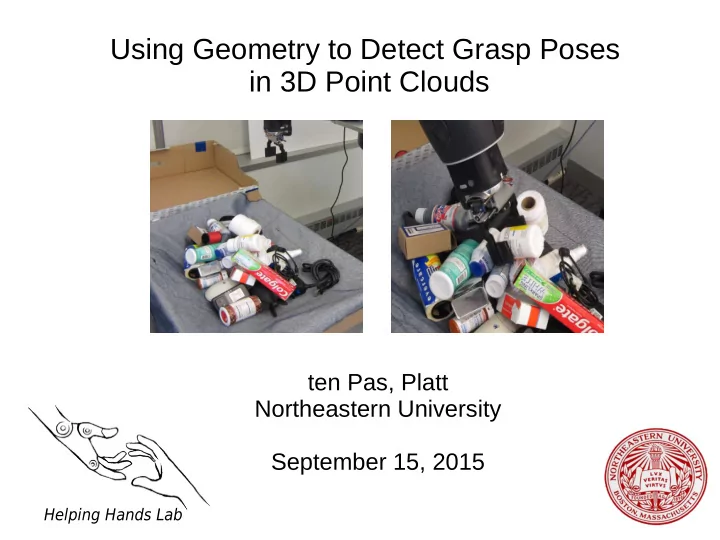

Using Geometry to Detect Grasp Poses in 3D Point Clouds ten Pas, Platt Northeastern University September 15, 2015 Helping Hands Lab
Objective Three possibilities: – Instance-level grasping – Category-level grasping – Novel object grasping
Objective Three possibilities: – Instance-level grasping – Category-level grasping – Novel object grasping The robot has a detailed description of the object to be grasped.
Objective Grasp the banana Three possibilities: – Instance-level grasping – Category-level grasping – Novel object grasping The robot has general information about the object to be grasped.
Objective Three possibilities: – Instance-level grasping Grasp the thing in the box – Category-level grasping – Novel object grasping The robot has no information about the object to be grasped.
Objective Three possibilities: “Easier” – Instance-level grasping – Category-level grasping – Novel object grasping “Harder”
Objective Most research assumes this Three possibilities: “Easier” – Instance-level grasping – Category-level grasping – Novel object grasping “Harder”
Objective Three possibilities: Our focus: – Instance-level grasping 1. Grasping novel or partially – Category-level grasping known objects – Novel object grasping 2. Robustness in clutter Related Work: 1. Fischinger and Vincze. Empty the basket - a shape based learning approach for grasping piles of unknown objects. IROS'12. 2. Fischinger et al. Learning grasps for unknown objects in cluttered scenes. IROS 2013. 3. Jiang et al. Efficient grasping from rgbd images: Learning using a new rectangle representation. IROS 2011. 4. Klingbeil et al. Grasping with application to an autonomous checkout robot. IROS 2011. 5. Lenz et al. Deep learning for detecting robotic grasps. RSS 2013.
Differences to Prior Work – Localizing 6-DOF poses instead of 3-dof grasps – Point clouds obtained from multiple range sensors instead of a single RGBD image – Systematic evaluation in clutter
Novel Object Grasping
Novel Object Grasping Input: a point cloud Output: hand poses where a grasp is feasible.
Novel Object Grasping Each blue line represents a full 6- DOF hand pose Input: a point cloud Output: hand poses where a grasp is feasible.
Novel Object Grasping Each blue line represents a full 6- DOF hand pose Input: a point cloud Output: hand poses where a grasp is feasible. – don't use any information about object identity
Why Novel Object Grasping is Hard what was there what the robot saw
Why Novel Object Grasping is Hard
Why Novel Object Grasping is Hard what was there what the robot saw what the robot saw (monocular depth) (stereo depth)
Our Algorithm has Three Steps 1. Hypothesis generation 2. Classification 3. Outlier removal
Our Algorithm has Three Steps 1. Hypothesis generation 2. Classification 3. Outlier removal
Step 2: Grasp Classification We want to check each hypothesis to see if it is an antipodal grasp
If we had a “perfect” point cloud... … then we could check geometric sufficient conditions for a grasp We would check whether an antipodal grasp would be formed when the fingers close
If we had a “perfect” point cloud... Missing these points! But, this is closer to reality... So, how do we check for a grasp now?
If we had a “perfect” point cloud... Missing these points! But, this is closer to reality... Machine Learning So, how do we check for a grasp now? (i.e. classification)
Classification We need two things: 1. Learning algorithm + feature representation 2. Training data
Classification We need two things: 1. Learning algorithm + feature representation – SVM + HOG – CNN 2. Training data
Classification We need two things: 1. Learning algorithm + feature representation – SVM + HOG – CNN 2. Training data – automatically extract training data from arbitrary point clouds containing graspable objects
Training Set
Training Set 97.8% accuracy (10-fold cross validation)
Test Set
Test Set 94.3% accuracy on novel objects
Experiment: Grasping Objects in Isolation
Results: Objects Presented in Isolation
Experiment: grasping objects in clutter
Results: Clutter 73% average grasp success rate in 10-object dense clutter
Conclusions ● New approach to novel object grasping ● Use grasp geometry to label hypotheses automatically ● Average grasp success rates: ● 88% for single objects ● 73% in dense clutter
Questions? atp@ccs.neu.edu http://www.ccs.neu.edu/home/atp ROS packages – Grasp pose detection: wiki.ros.org/agile_grasp – Grasp selection: github.com/atenpas/grasp_selection
Recommend
More recommend